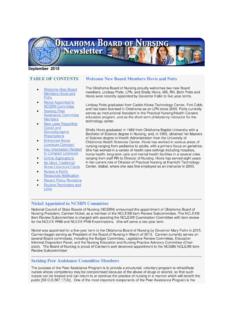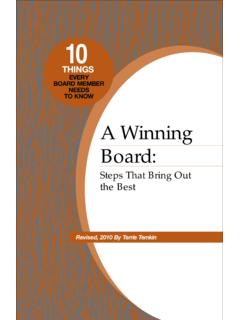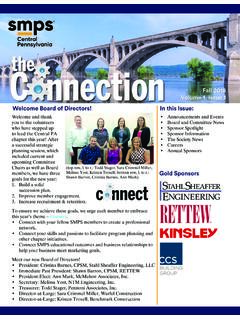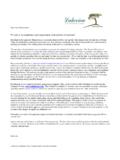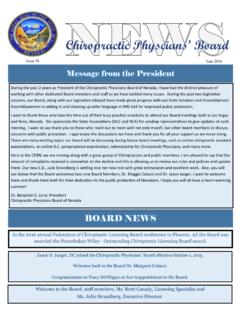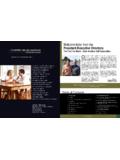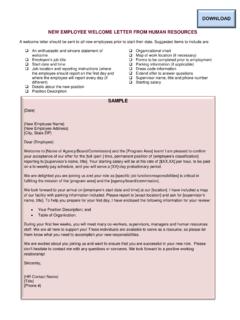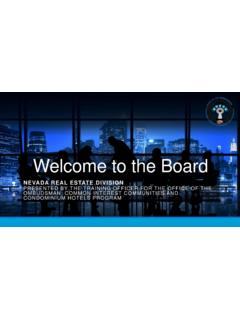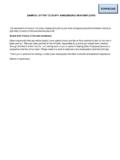Transcription of Create a Digital Welcome Board Display - FrontFace for ...
1 1 FrontFace Quickstart Tutorial Welcome Boards with FrontFace : Learn how to build your own, personalized reception screen for visitors! A l ar ge sc r e en i n t h e l ob by or r ec e pt i o n a r e a , n ot o nl y f or di s pl ay i n g g en er al i n f o r m at i on ab o ut y ou r c om p any a n d c or p or at e ne ws, but al s o f or w el c om i n g v i si t or s i n a pe r s on al i z ed way! W h et he r f u l l y aut om at i c ( t i m e-c ont r o l l e d) o r m a nu al l y t r i g g er e d ( a d-h oc ) t h e di g i t al si g na ge s of t w ar e Fr ont F ac e by m i r a by t e hel p s y o u t o i m pl em ent y ou r o wn, p r of es si on al wel c om e b oa r d ea si l y an d c onv en i ent l y ! H ow t hi s ac t u al l y w or k s i s e xpl ai ne d i n t hi s t ut or i a l.
2 1 Downloading and Installing FrontFace : First, please visit the FrontFace product website and click on the button to download the trial version (or the full version if you have a license). After the download, run the installation package on your workstation PC, and select the installation option "Full Installation (incl. FrontFace Assistant)." 2 Installation of the Player PC: The FrontFace software consists of two components, the FrontFace Assistant for creating and configuring your projects and the FrontFace Player App for actually playing your content on the large screen or a TV. So far, you have only installed the FrontFace Assistant on your workstation PC. The PC that is connected to your large screen or TV is called a "player PC" ( a mini PC). Please execute the installation package you just downloaded also on that PC. During the installation process, select the installation option "Install Player App only (for installation on a player PC).
3 " During the installation process, a network share is created automatically (please write down the address!), which is used later on to remotely update the player PC from your workstation PC using the FrontFace Assistant. This, of course, requires that your workstation PC and the player PC are in the same local area network. After having installed the FrontFace Player App on the player PC, you may also need to explicitly allow access to network shares in Windows system settings. How to do that is described in detail in our FAQ: The last step is to launch the FrontFace Player App from the Windows start menu. After a few seconds, a message appears telling you that no content has been published yet. The player is now good to go: 3 Creating a Project for the Welcome Screen: Now head back to your workstation PC and open the FrontFace Assistant from the Windows start menu, and click on "New Project" on the home page of the application: 2 Enter a name for the project ( " Welcome Screen") and then select a suitable location on your hard disk for the project, such as "Documents.
4 " As project type you should select " Digital Signage." In the "Player" section of the Assistant, you must first enter the address of the network share of your player PC, which was been created during the installation in step 2. This is usually: \\NAME-OF-PC\ FrontFace 4 Creating a Default Playlist In order for something to appear on your screen even when no visitors are currently being welcomed, first Create a "default playlist." This playlist can contain things like news headlines, general information about your business or some photos or videos. Now head over to the "Contents" section: A playlist named "Playlist 1" has already been created. Double-click that entry and rename the playlist to "Default." Confirm with OK and then add a page to the playlist by clicking the "+" button above the list of pages: Then the settings dialog of the new page appears.
5 Just click OK and in the next dialog, select the desired media object that you want to Display on this page, a picture: Of course, you can also select a different page layout and then add multiple media objects on the page. Following the same pattern, you can Create further pages. For more details about creating playlists and design options, please see the FrontFace user manual. If you would like to preview your playlist or a page ( , see the content as it will appear later on the player), just click the preview button of the playlist or a page: 5 Creating a Welcome Playlist Next, Create another playlist that contains a page with the Welcome message. Click on the "+" button above the "Playlists & Menus" list and name the playlist " Welcome " and confirm with OK. Then add a single page to this playlist. In order to make the presentation of the visitor greeting a little more appealing, please select the layout "Overlay + Edge" as the page layout (you have to scroll down in the drop-down list of layouts!)
6 After confirming with "OK," the new page has been added to your playlist. In the "Contents of .." area, you now see the layout of the page consisting of two containers, one that will host a wallpaper picture in the background ( ) and the other slightly smaller one in the foreground ( ) that will host the Welcome text: First, click on the background container and select "Picture" as Media Object. Next, select a JPEG or PNG graphic from your hard drive that 3 will serve as the Welcome page's wallpaper. After you have selected the image file, change the "Stretching" to "Uniform to Fill" and confirm with "OK." Next, click on the container in the foreground of the page and select "Text" as the Media Object. Write and format your Welcome message with the text editor and use a placeholder for the visitor name (for example, ${Visitor Name}).
7 You can enter the placeholder by hand as shown in the picture below or by using the "Insert placeholder .." button. The placeholder will be replaced later on with the name of the visitor that is to be welcomed. Change the background color to "Transparent" (), so that your background image on the page is visible. Now that you have created both your default playlist and the Welcome playlist, you will need to decide how to control the Welcome message on the screen. There are three options to choose from: 1.) Automatic, Timer-based Scheduling: Here, you use the scheduling feature of FrontFace to determine at which date/time which visitors should be welcomed. Please continue with step 6. 2.) Automatic Scheduling from External Sources: Here you access an external calendar as the data source for visitor appointments, , from an Exchange calendar, which can then be maintained using Outlook.
8 Please continue with step 7. 3.) Manual Triggering: Here you can decide immediately whether the Welcome message or the default playlist shall run. This mode makes sense if your visitors arrive "spontaneously." Please continue with step 8. 6 Setting up the Scheduling In the simplest case, you manage the times you want to Welcome your visitors directly withinin FrontFace . Go to the "Scheduling" menu and activate the "Advanced Scheduling" for the screen connected to your player PC: To ensure that your default playlist is always displayed when no visitor is being welcomed, make sure that a "Daily Timer" is set from 00:00 to 23:59 and plays the "Standard" playlist. Now, by clicking on the "+" button in the list of timers, you can add more "One-Time Timers" to each of which you assign the " Welcome " playlist. The start/end date and time are set here to the desired period when a visitor is to be welcomed.
9 Finally, in the settings dialog of the timer, switch to the tab "Placeholder" and enter the name of your visitor for the placeholder ${Visitor Name}, who should be welcomed to this appointment: Following the same pattern, you can Create additional timers for additional visitors. The Preview tab at the bottom of the Display control lets you see a calendar view that gives you easy control over which playlist plays: 7 Alternative: Integration of External Calendars Instead of integrated scheduling of FrontFace , you can also use external calendars to control the Welcome messages on the screen. First activate the "Advanced Scheduling" (see step 6). Then Create a 4 "Daily Timer" for the default playlist. Instead of "One-Time Timers" (see step 6), you add a so-called "Event Source": Here you have to select an event source plugin.
10 Please download the event source plugin "Calendar Trigger" from the FrontFace website and install it in your project. Then you can, for example, select a calendar from an Exchange server as data source (which can be maintained using the Outlook client!). The placeholders in this case are predefined, for example to include the field "Subject" of an appointment. Please refer to the user manual of the Calendar Trigger Plugin for more details. You can open this via the plugin's settings dialog or download it from the FrontFace website. The supported data sources of the Calendar Trigger Plugin include Microsoft Exchange Server, Lotus Domino (Notes}, Excel and iCalendar/ICS. 8 Alternative: Manual Triggering of the Welcome Screen In case you want to spontaneously switch between the default playlist and the Welcome playlist, you can also run an ad-hoc Welcome system without time control.)
